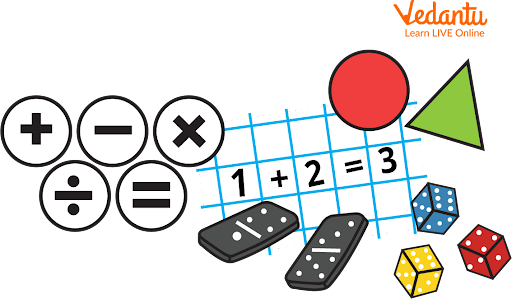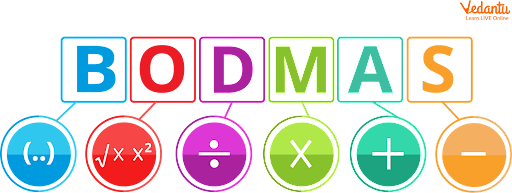




How to Apply BODMAS Rule in Maths Problems
Math is all about logic and following a few simple BODMAS rules to make our calculations go more smoothly. BODMAS was invented by Achilles Reselfelt, a mathematician. It's a mnemonic for remembering how to evaluate mathematical operators in a mathematical statement with several mathematical operations. It is the simplest way to solve an expression with multiple operators.
BODMAS is used to simplify an expression or equation which is combined two or more numbers with the most often used mathematical operators: Addition (+), Subtraction (-), multiplication (x) and Division (÷).

Mathematical Operators
What is BODMAS?
The order of operations, or BODMAS, is a sequence for performing operations in an arithmetic statement. As a result, BODMAS is one of the basic principles for simplifying multiple-operator expressions. The BODMAS rule does not cover equations. It can be used on mathematical expressions with many operators.
BODMAS Rule
Have you ever thought about how long mathematical expressions having more than two operators are simplified? According to the BODMAS rule, mathematical expressions with numerous operators must be solved from left to right in the BODMAS order. Division and multiplication are interchangeable and are determined by which comes first in the phrase, as are addition and subtraction.
BODMAS Stands for:-
B - Bracket
O - Order of (square, indices etc.)
D - Division
M - Multiplication
A - Addition
S - Subtraction

BODMAS Rule
How to Apply BODMAS?
When there are several operators in an expression, the BODMAS rule can be used. In that instance, we first simplify the brackets from the innermost to the outermost [()], then assess the values of exponents or roots, simplify multiplication and division, and finally perform addition and subtraction operations while moving from left to right.
Let’s start simplifying expressions in the following order
Bracket: Calculate everything inside the bracket first.
For example:
$4 \times(12-9)$
$=4 \times 3$
$=12$
The correct answer is 12 by using the BODMAS rule.
Order of: Solve the power, square etc.
For example:
$5+4^{2}$
$=5+16$
$=21$
The correct answer is 21 by using the BODMAS rule.
Division and Multiplication: Since multiplication and division are equally important, they should be completed from left to right.
For example:
$6+24 \div 3 \times 2$
$=6+8 \times 2$
$=6+16$
$=22$
The correct answer is 22 by using the BODMAS rule.
Addition and Subtraction: Since addition and subtraction are equally important, they should be completed from left to right.
$21+(8-5)$
$=21+3$
$=24$
The correct answer is 24 by using the BODMAS rule.
BODMAS without Brackets
We can also apply this rule if there are no brackets; go to indices, then multiplication and division, and finally addition and subtraction. One instructs you to multiply first, then divide, whereas the other instructs you to do the opposite.
Here is a BODMAS Example with Answer.
Q. Simplify $3+4 \times 2+4-1$
Ans. BODMAS says Multiplication first,
so multiply, $4 \times 2$
$3+8+4-1$
Solving addition next,
$3+8+4=15$
Now perform subtraction at last
$15-1=14$
The correct answer is 14 by using the BODMAS rule.
BODMAS Rule Problems
Problem 1: Simplify $12 \div 4 \times 2+3^{2}-(9+4)$.
Solution: Using the BODMAS Rule (left to right whichever operations come first we will follow that).
$12 \div 4 \times 2+3^{2}-(9+4)$
First we will simplify bracket,
$=12 \div 4 \times 2+3^{2}-13$
Now we will simplify powers,
$=12 \div 4 \times 2+9-13$
Now we will divide 12 by 4,
$=3 \times 2+9-13$
Now we will multiply 3 and 2,
$=6+9-13$
Now we will add and subtract,
$=15-13$
$=2$
Problem 2: Simplify the expression by using the BODMAS rule: $(9 \times 3 \div 9+1) \times 3$.
Solution: Step 1: Using BODMAS Rule (left to right whichever operations come first we will follow that). Here, first, we simplify the bracket and inside the bracket, we will multiply first then division (we can do vice versa) and then addition. Thus, we need to multiply 9 by 3 in the given expression,
$(9 \times 3 \div 9+1) \times 3$ and we get,
$(27 \div 9+1) \times 3$
Step 2: Now, we need to divide 27 by 9 inside the bracket, and we get, $(3+1) \times 3$
Step 3: Remove the parentheses after adding 3 and 1 ,
we get, $4 \times 3$
Step 4: Multiply 4 by 3 to get the final answer, which is 12.
$\therefore(9 \times 3 \div 9+1) \times 3=12$
Summary
The BODMAS is a sequence for performing operations in an arithmetic statement. Here B stands for Brackets, O for Order of powers or roots, D for Division, M for Multiplication A for Addition, and S for Subtraction. This indicates that expressions with numerous operators must be simplified in this order only, from left to right. We start with brackets, then powers or roots, division or multiplication (whichever comes first from the left side of the expression), and finally subtraction or addition (whichever comes first from the left side of the expression).
If there are no brackets, we utilise the BODMAS rule to get the desired result. If there are no brackets, start with 'order' or 'of,' then divide or multiply (whichever comes first from left to right), and last add or subtract (whatever comes first from left to right).
Practice on Your Own
Q1. Simplify the expression by using the BODMAS rule: $3+4 \times 2+4-1$.
Ans: 14
Q2. Simplify the expression by using the BODMAS rule: $(27 \div 9+1) \times 3$.
Ans: 12
FAQs on BODMAS Rule Made Easy: Definition, Examples & Solutions
1. What is the BODMAS rule in Maths?
The BODMAS rule is a fundamental principle in mathematics that dictates the correct sequence for solving an expression with multiple operations. It ensures that anyone solving the problem arrives at the same, single correct answer. The acronym stands for:
- B - Brackets (Solve all operations within brackets first)
- O - Orders (Powers, square roots, etc.)
- D - Division
- M - Multiplication
- A - Addition
- S - Subtraction
You must work through the operations in this specific order to get the right result.
2. Can you explain the BODMAS rule with a simple example?
Certainly. Let's solve the expression 20 + (5 × 2)² - 12 ÷ 4 using the BODMAS rule step-by-step.
- Brackets: First, solve the operation inside the brackets: (5 × 2) = 10. The expression becomes 20 + 10² - 12 ÷ 4.
- Orders: Next, solve the power (order): 10² = 100. The expression becomes 20 + 100 - 12 ÷ 4.
- Division: Now, perform the division: 12 ÷ 4 = 3. The expression becomes 20 + 100 - 3.
- Addition: Perform the addition: 20 + 100 = 120. The expression becomes 120 - 3.
- Subtraction: Finally, perform the subtraction: 120 - 3 = 117.
Therefore, the correct answer is 117.
3. How do you apply the BODMAS rule step-by-step?
To apply the BODMAS rule correctly, follow these steps in sequence:
- Step 1 (Brackets): Begin by simplifying any expressions inside brackets. If there are nested brackets, start with the innermost one first.
- Step 2 (Orders): After brackets, calculate any powers or square roots.
- Step 3 (Division and Multiplication): Perform all division and multiplication operations. It is crucial to work from left to right as these two operations have equal priority.
- Step 4 (Addition and Subtraction): Finally, perform all addition and subtraction. Similar to the previous step, work from left to right as these also have equal priority.
4. Why is it important to follow the BODMAS rule in calculations?
Following the BODMAS rule is crucial for consistency and accuracy in mathematics. Without a standard order of operations, a single mathematical expression could have multiple different answers depending on who solves it and in what order. BODMAS provides a universal convention that ensures everyone, from students to scientists, arrives at the same correct result for a given calculation, making it a fundamental grammar of mathematics.
5. What is the difference between BODMAS and PEMDAS?
There is no functional difference between BODMAS and PEMDAS; they represent the same order of operations but use different terminology, primarily due to regional language differences.
- BODMAS (Brackets, Orders, Division, Multiplication, Addition, Subtraction) is commonly used in India and the UK.
- PEMDAS (Parentheses, Exponents, Multiplication, Division, Addition, Subtraction) is commonly used in the USA.
'Brackets' and 'Parentheses' are the same, as are 'Orders' and 'Exponents'. The core principle of solving in that specific sequence remains identical.
6. How is the BODMAS rule applied to expressions that include fractions?
When an expression involves fractions, you should simplify the fraction first. Think of the numerator and the denominator as being enclosed in their own invisible brackets. You must calculate their values separately before performing the division that the fraction represents. Once the fraction is simplified into a single number, you can proceed with the rest of the expression following the standard BODMAS sequence.
7. Are there any situations where the BODMAS rule can be confusing?
Yes, a common point of confusion arises with Division/Multiplication and Addition/Subtraction. Students sometimes believe Division must always come before Multiplication. However, these pairs have equal priority. The correct method is to solve them as they appear from left to right in the expression. For example, in 16 ÷ 4 × 2, you must perform division first (16 ÷ 4 = 4) and then multiply (4 × 2 = 8). Reversing the order would give an incorrect answer of 2.















